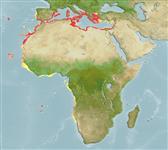Teleostei (teleosts) >
Eupercaria/misc (Various families in series Eupercaria) >
Sparidae (Porgies)
Etymology: Diplodus: Greek, diploos = twice + Greek, odous = teeth (Ref. 45335).
More on author: Walbaum.
Environment: milieu / climate zone / depth range / distribution range
Ecology
Marine; brackish; benthopelagic; oceanodromous (Ref. 51243); depth range 0 - 150 m (Ref. 2683), usually 0 - 60 m (Ref. 3688). Subtropical; 42°N - 28°S, 26°W - 42°E
Eastern Atlantic: Bay of Biscay (rare) to Sierra Leone, the Canary Islands, and Cape Verde, including the Mediterranean and Strait of Gibraltar and Black Sea (Ref. 4781). Also off South Africa.
Size / Weight / Age
Maturity: Lm ? range ? - ? cm
Max length : 60.0 cm TL male/unsexed; (Ref. 3397); common length : 30.0 cm TL male/unsexed; (Ref. 3688); max. published weight: 1.7 kg (Ref. 40637)
Benthopelagic marine species. Gregarious species living in coastal waters on rocky or sandy bottoms, up to 1 50 m (only occasionally over 50 m). Younger individuals can also be found in brackish waters and may live in littoral pools (sometimes in brackish waters and lagoons), the adults often occur in the surf zone. Feeds on seaweeds, worms, mollusks and shrimps (Ref. 4781). Very common in the Mediterranean. In the Atlantic occurs from Gibraltar to the coasts off Sierra Leone, including the coasts of the Canary Islands and Cape Verde. Less often found off the Iberian Atlantic coasts and Bay of Biscay. Scarce in the Black Sea. Permanent hermaphrodite species with some protandric episodes (behaving as male after its first sexual maturity to become female later on). Reproduction happens by the end of the summer and autumn. Egg size 0.85 mm, larval length at hatching 1.7 mm.
Bauchot, M.-L. and J.-C. Hureau, 1990. Sparidae. p. 790-812. In J.C. Quero, J.C. Hureau, C. Karrer, A. Post and L. Saldanha (eds.) Check-list of the fishes of the eastern tropical Atlantic (CLOFETA). JNICT, Lisbon; SEI, Paris; and UNESCO, Paris. Vol. 2. (Ref. 3688)
IUCN Red List Status (Ref. 130435)
Threat to humans
Harmless
Human uses
Fisheries: commercial; gamefish: yes
Tools
Special reports
Download XML
Internet sources
Estimates based on models
Preferred temperature (Ref.
123201): 16 - 21.6, mean 19.1 °C (based on 294 cells).
Phylogenetic diversity index (Ref.
82804): PD
50 = 0.5000 [Uniqueness, from 0.5 = low to 2.0 = high].
Bayesian length-weight: a=0.01202 (0.00979 - 0.01476), b=3.04 (3.01 - 3.07), in cm total length, based on LWR estimates for this species (Ref.
93245).
Trophic level (Ref.
69278): 3.2 ±0.0 se; based on diet studies.
Generation time: 4.1 ( na - na) years. Estimated as median ln(3)/K based on 1
growth studies.
Resilience (Ref.
120179): Medium, minimum population doubling time 1.4 - 4.4 years (tm=3).
Fishing Vulnerability (Ref.
59153): Moderate vulnerability (40 of 100).
Climate Vulnerability (Ref.
125649): Low to moderate vulnerability (30 of 100).
Nutrients (Ref.
124155): Calcium = 55.7 [32.5, 101.4] mg/100g; Iron = 0.89 [0.51, 1.53] mg/100g; Protein = 19.3 [18.4, 20.3] %; Omega3 = 0.383 [0.203, 0.729] g/100g; Selenium = 33.3 [17.0, 57.5] μg/100g; VitaminA = 11.3 [3.7, 29.7] μg/100g; Zinc = 0.88 [0.62, 1.22] mg/100g (wet weight); based on
nutrient studies.
